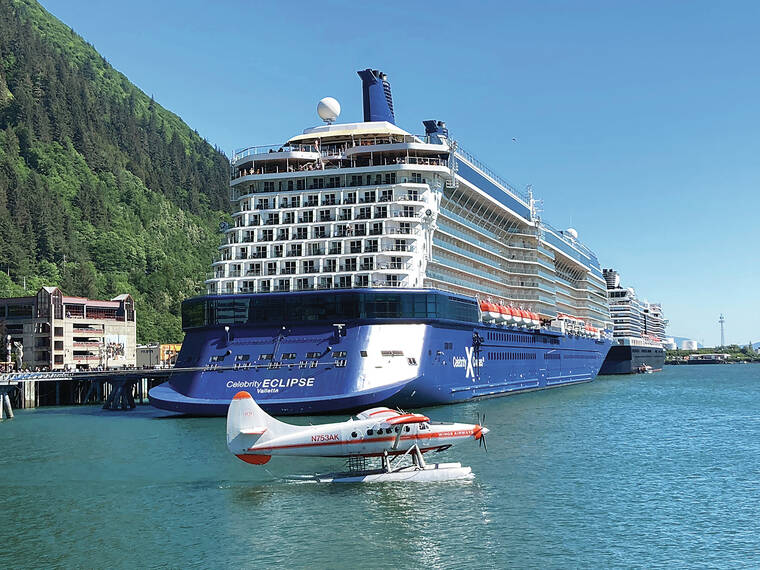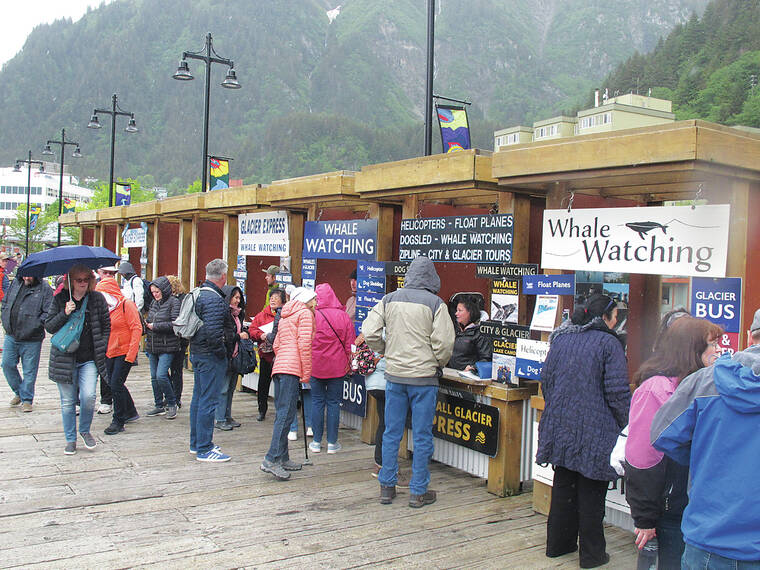Crammed with tourists, Alaska’s capital wonders what will happen as its magnificent glacier recedes
JUNEAU, Alaska — Thousands of tourists spill onto a boardwalk in Alaska’s capital city every day from cruise ships towering over downtown. Vendors hawk shoreside trips and rows of buses stand ready to whisk visitors away, with many headed for the area’s crown jewel: the Mendenhall Glacier.
A craggy expanse of gray, white and blue, the glacier gets swarmed by sightseeing helicopters and attracts visitors by kayak, canoe and foot. So many come to see the glacier and Juneau’s other wonders that the city’s immediate concern is how to manage them all as a record number are expected this year. Some residents flee to quieter places during the summer, and a deal between the city and cruise industry will limit how many ships arrive next year.
But climate change is melting the Mendenhall Glacier. It is receding so quickly that by 2050, it might no longer be visible from the visitor center it once loomed outside.
That’s prompted another question Juneau is only now starting to contemplate: What happens then?
“We need to be thinking about our glaciers and the ability to view glaciers as they recede,” said Alexandra Pierce, the city’s tourism manager. There also needs to be a focus on reducing environmental impacts, she said. “People come to Alaska to see what they consider to be a pristine environment and it’s our responsibility to preserve that for residents and visitors.”
The glacier pours from rocky terrain between mountains into a lake dotted by stray icebergs. Its face retreated eight football fields between 2007 and 2021, according to estimates from University of Alaska Southeast researchers. Trail markers memorialize the glacier’s backward march, showing where the ice once stood. Thickets of vegetation have grown in its wake.
While massive chunks have broken off, most ice loss has come from the thinning due to warming temperatures, said Eran Hood, a University of Alaska Southeast professor of environmental science. The Mendenhall has now largely receded from the lake that bears its name.
Scientists are trying to understand what the changes might mean for the ecosystem, including salmon habitat.
There are uncertainties for tourism, too.
Most people enjoy the glacier from trails across Mendenhall Lake near the visitor center. Caves of dizzying blues that drew crowds several years ago have collapsed and pools of water now stand where one could once step from the rocks onto the ice.
Manoj Pillai, a cruise ship worker from India, took pictures from a popular overlook on a recent day off.
“If the glacier is so beautiful now, how would it be, like, 10 or 20 years before? I just imagine that,” he said.
Officials with the Tongass National Forest, under which the Mendenhall Glacier Recreation Area falls, are bracing for more visitors over the next 30 years even as they contemplate a future when the glacier slips from casual view.
The agency is proposing new trails and parking areas, an additional visitor center and public use cabins at a lakeside campground. Researchers do not expect the glacier to disappear completely for at least a century.
“We did talk about, ‘Is it worth the investment in the facilities if the glacier does go out of sight?’” said Tristan Fluharty, the forest’s Juneau district ranger. “Would we still get the same amount of visitation?”
A thundering waterfall that is a popular place for selfies, salmon runs, black bears and trails could continue attracting tourists when the glacier is not visible from the visitor center, but “the glacier is the big draw,” he said.
Around 700,000 people are expected to visit this year, with about 1 million projected by 2050.
Other sites offer a cautionary tale. Annual visitation peaked in the 1990s at around 400,000 to the Begich, Boggs Visitor Center, southeast of Anchorage, with the Portage Glacier serving as a draw. But now, on clear days, a sliver of the glacier remains visible from the center, which was visited by about 30,000 people last year, said Brandon Raile, a spokesperson with the Chugach National Forest, which manages the site. Officials are discussing the center’s future, he said.
“Where do we go with the Begich, Boggs Visitor Center?” Raile said. “How do we keep it relevant as we go forward when the original reason for it being put there is not really relevant anymore?”
At the Mendenhall, rangers talk to visitors about climate change. They aim to “inspire wonder and awe but also to inspire hope and action,” said Laura Buchheit, the forest’s Juneau deputy district ranger.
After pandemic-stunted seasons, about 1.6 million cruise passengers are expected in Juneau this year, during a season stretching from April through October.



